Sharks are enigmatic predators, often misunderstood, that thrive in the Caribbean’s warm embrace. Aruba is known for its stunning beaches and vibrant culture. It is also a hub for shark enthusiasts and marine researchers eager to unravel the secrets of these majestic creatures. Let’s take a look at some of the most common species found in the waters of Aruba.

1. Nurse Shark

Nurse sharks are not typically aggressive when compared to other shark species and are generally safe to be around, and there are many diving sessions led by professional divers in which tourists can view nurse sharks in person.
©Divepic/ via Getty Images
Nurse sharks, scientifically known as Ginglymostoma cirratum, are fascinating creatures commonly found in the warm waters of the Caribbean Sea, including the beautiful island of Aruba. These sharks are distinctive due to their sluggish nature. They reach lengths of up to 14 feet and have a unique appearance with barbels near their mouths, which resemble catfish whiskers.
In Aruba, nurse sharks can be spotted in various coastal areas. Some of the most common sightings occur near popular beaches like Baby Beach, Malmok Beach, and Arashi Beach. These areas offer excellent snorkeling and diving opportunities, allowing enthusiasts to observe nurse sharks up close. The calm, clear waters and abundance of reef fish make these beaches attractive to nurse sharks. This is because they primarily feed on small fish, crustaceans, and mollusks.
Fortunately, nurse sharks are generally considered harmless to humans. They are bottom-dwellers who spend the daytime in crevices and are mostly active at night. They are unlikely to pose a threat to beachgoers and swimmers due to their placid nature and predilection for smaller prey.
Aruba has not witnessed a history of nurse shark attacks on humans. These sharks are not aggressive predators, and they rarely interact with people unless provoked or mishandled. Nevertheless, visitors must respect these marine animals’ natural behaviors and habitats and avoid disturbing them in their resting spots. Responsible tourism practices and adherence to local guidelines can ensure peaceful coexistence between humans and nurse sharks in the waters of Aruba, allowing everyone to appreciate the beauty of these unique creatures in their natural environment.
2. Lemon Shark
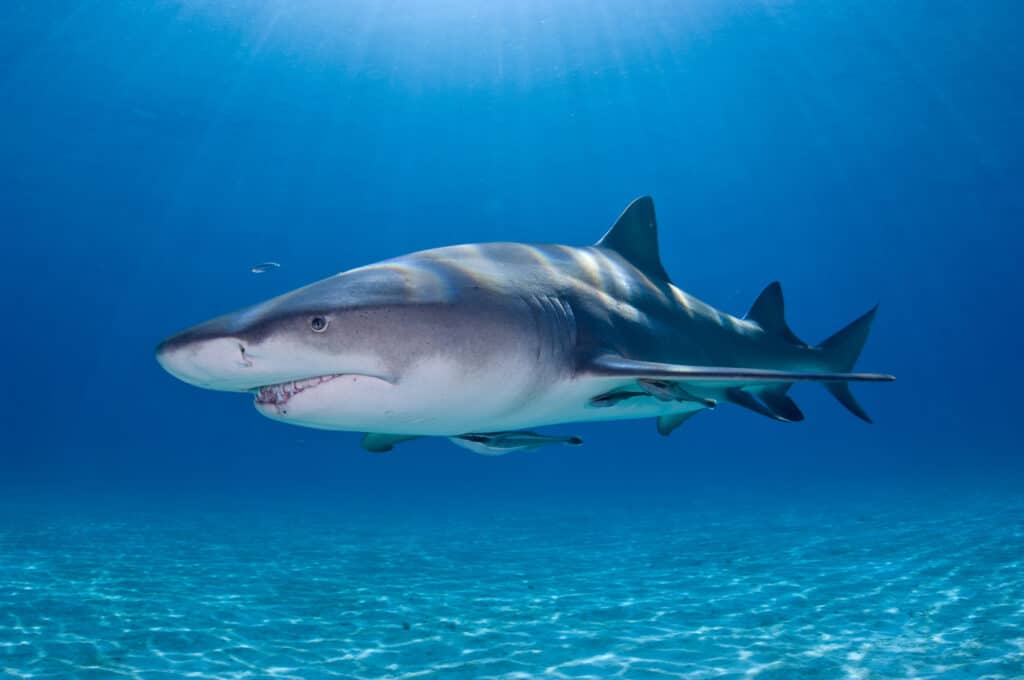
Lemon sharks are not typically dangerous and cases of bites or attacks are very rare, provided swimmers take the right safety precautions and use common sense when swimming in the ocean.
©iStock.com/uwimages
Lemon sharks, scientifically known as Negaprion brevirostris, are a species of sharks that frequent the warm waters around Aruba. These sharks are named for their distinctive yellowish-brown coloration and are known for their docile nature.
In Aruba, lemon sharks can often be found near various beaches and coastal areas. The most frequent sightings occur in locations like Boca Catalina, Mangel Halto, and Arashi Beach. These areas are favored by lemon sharks due to the presence of rich marine life and coral reefs, which serve as hunting grounds for these predators. Lemon sharks primarily feed on fish, rays, and crustaceans, making these coastal waters an ideal habitat.
Luckily, lemon sharks are not considered a threat to humans. They are generally non-aggressive and do not actively seek human interaction. Shark attacks involving lemon sharks in Aruba are extremely rare, and there is no documented history of such incidents. These sharks typically swim in shallow waters and are more interested in their natural prey than in people.
Nonetheless, beachgoers and divers need to exercise caution and follow safety guidelines when in the water. Respecting these magnificent creatures’ space and not disturbing them is crucial for maintaining the peaceful coexistence between humans and lemon sharks in Aruba’s marine ecosystem.
3. Bull Shark
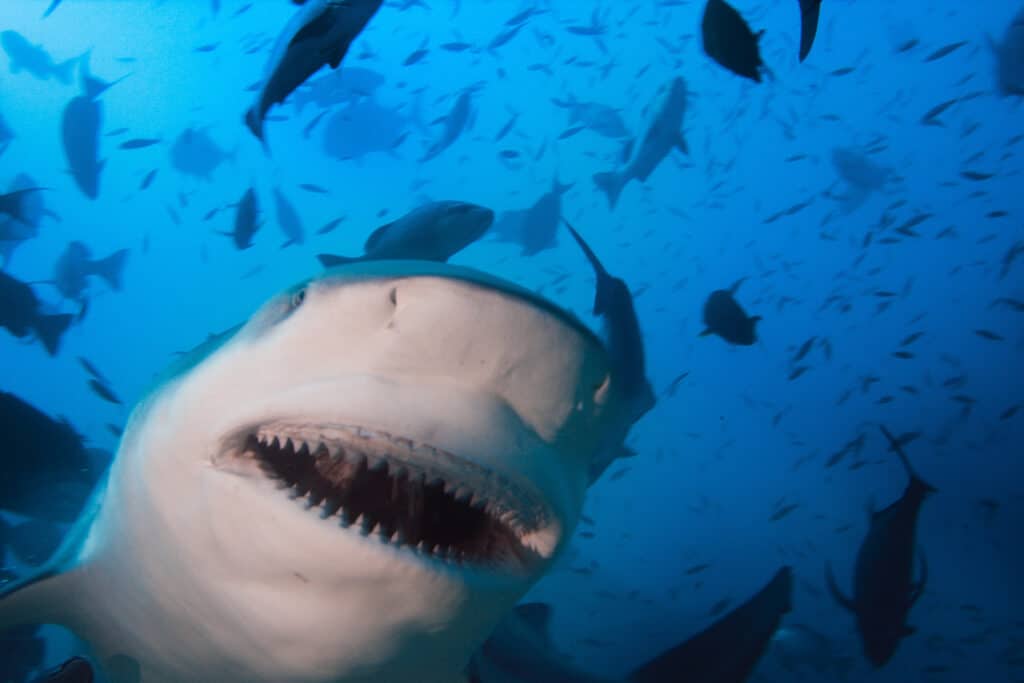
Bull sharks are known for being aggressive and territorial, but there have been no recorded cases of this species attacking humans in Aruba, though there have been over 119 recorded attacks in recent history in other areas of the world.
©Willyam Bradberry/Shutterstock.com
Bull sharks, also known by their scientific name Carcharhinus leucas, are powerful and fearsome predators that frequent the seas of Aruba. Since they can survive in both saltwater and freshwater habitats, including estuaries and rivers, these sharks are renowned for their adaptability.
Bull sharks are commonly seen in Aruba’s coastal regions, with major sightings occurring close to well-known beaches including Boca Catalina, Malmok Beach, and the vicinity of the California Lighthouse. These areas include a combination of shallow and deeper seas, giving these sharks plenty of possibilities to pursue their food, which can include a variety of fish species and even other sharks.
There is no recorded evidence of bull shark attacks on people in these parts of Aruba. When diving or swimming in areas where bull sharks may be present, it’s crucial to use caution. These sharks have a reputation for acting aggressively and territorially when provoked or threatened. Bull shark attacks are uncommon, but it’s important to respect their environment. Always follow safety precautions to ensure that people and these apex predators may enjoy the ocean in peace.
Aruba’s stunning beaches and crystal-clear seas continue to draw tourists and thrill-seekers, so both locals and guests must be mindful of the island’s marine life and act responsibly when taking advantage of its aquatic delights.
4. Caribbean Reef Shark
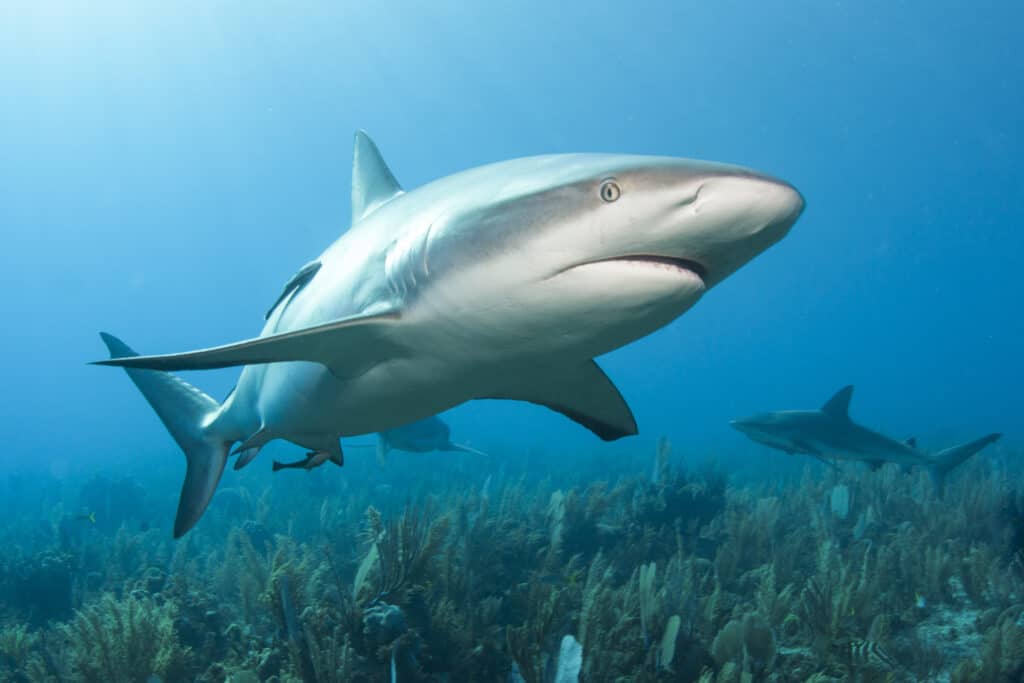
Caribbean reef sharks are known for being quite large, but they are considered relatively non-aggressive to humans and are more interested in fish and other sharks.
©Konstantin Novikov/Shutterstock.com
Sharks known as Caribbean reef sharks, or Carcharhinus perezi, are frequently seen in the warm, clear waters of the Caribbean Sea, which includes the stunning island of Aruba. These sharks are renowned for their elegant look, with a long, lean body that is colored grayish-blue on the dorsal side and lighter, silvery-white on the belly. They are effective predators because of their streamlined bodies, which allow them to glide through the water with ease.
The main food sources for Caribbean reef sharks include fish, crustaceans, and cephalopods such as squid and octopus. They are expert hunters and frequently cruise the coral reefs and other underwater environments that are teeming with marine life. With keen senses and sharp teeth, they are well-equipped to catch their prey.
In Aruba, the presence of Caribbean reef sharks is most commonly observed in popular diving spots. Some spots include the Antilla Shipwreck, the Pedernales wreck, and various reef formations off the coast. The island’s extensive coral reefs and vibrant underwater landscapes provide the ideal habitat and a rich source of food for these sharks.
Fortunately, Aruba has not experienced a history of shark attacks involving Caribbean reef sharks. These sharks are generally considered non-aggressive towards humans and are more interested in their natural prey. Divers and snorkelers often seek the opportunity to encounter these magnificent creatures up close, as they are a vital part of the marine ecosystem and contribute to the island’s thriving underwater biodiversity.
5. Hammerhead Shark

Hammerhead sharks are found throughout different offshore reefs surrounding Aruba, though spotting them can be difficult and rare due to their elusive nature.
©HakBak/Shutterstock.com
Hammerhead sharks are distinctive and fascinating creatures known for their unique appearance and behavior. They belong to the Sphyrnidae family and can be found in various oceans worldwide, including the waters surrounding the beautiful island of Aruba.
One of the defining features of hammerhead sharks is their flattened, T-shaped head, which resembles a hammer. This distinct head shape provides them with several advantages, including enhanced sensory perception. Their eyes and nostrils are positioned at the tips of their “hammer,” giving them a wider field of vision and an acute sense of smell. Hammerhead sharks typically have a grayish-brown or olive-green coloration, helping them blend into their marine environment.
When it comes to their diet, hammerhead sharks are opportunistic predators. They primarily prey on a variety of fish, including smaller sharks and rays, as well as squid and crustaceans. Their unique head shape allows them to locate and capture prey more effectively, making them efficient hunters.
In Aruba, hammerhead sharks can occasionally be spotted in different areas, including offshore reefs, the Antilla Shipwreck site, and deeper waters around the island. These locations offer an abundance of marine life, making them suitable hunting grounds for hammerheads.
Aruba has not recorded any significant history of shark attacks involving hammerhead sharks in its waters. These sharks are generally not considered a threat to humans unless provoked or cornered.
6. Blacktip Shark

Blacktip sharks are not considered particularly dangerous, as they are most interested in fish and crustaceans over humans swimming in their waters.
©Vladimir Wrangel/Shutterstock.com
The distinctive marine predators known as blacktip sharks, or Carcharhinus limbatus, are frequently seen in warm tropical and subtropical waters, including the coastlines around Aruba. These sharks are easily recognized thanks to their striking black patterns on the ends of their fins, which gave them their name.
Blacktip sharks are well-camouflaged in the open ocean because of their sleek bodies and bronze-gray or bluish-gray pigmentation on their dorsal side. They can merge in with the sunshine when seen from below because of their white bellies. Bigger individuals can reach heights of up to eight feet. However, they normally attain lengths of about five to six feet. These sharks are distinguished by their beautiful, slender look.
Blacktip sharks are opportunistic carnivores in terms of their nutrition. Smaller fish like sardines, mullet, and herring, as well as several types of squid and crabs, make up their main diet. Being skilled hunters, they are frequently spotted combing coral reefs and coastal waterways in quest of their next meal.
Blacktip sharks are regularly spotted in Aruba close to several beaches and coastal regions. Such areas include Palm Beach, Eagle Beach, and the nearby reef systems. These areas provide a wide variety of marine life, which attracts these sharks and makes them great hunting grounds.
There are no known blacktip shark attacks in Aruba’s recent history. Due to their preference for their native food over humans, these sharks are typically not seen as a threat to humans.
7. Tiger Shark
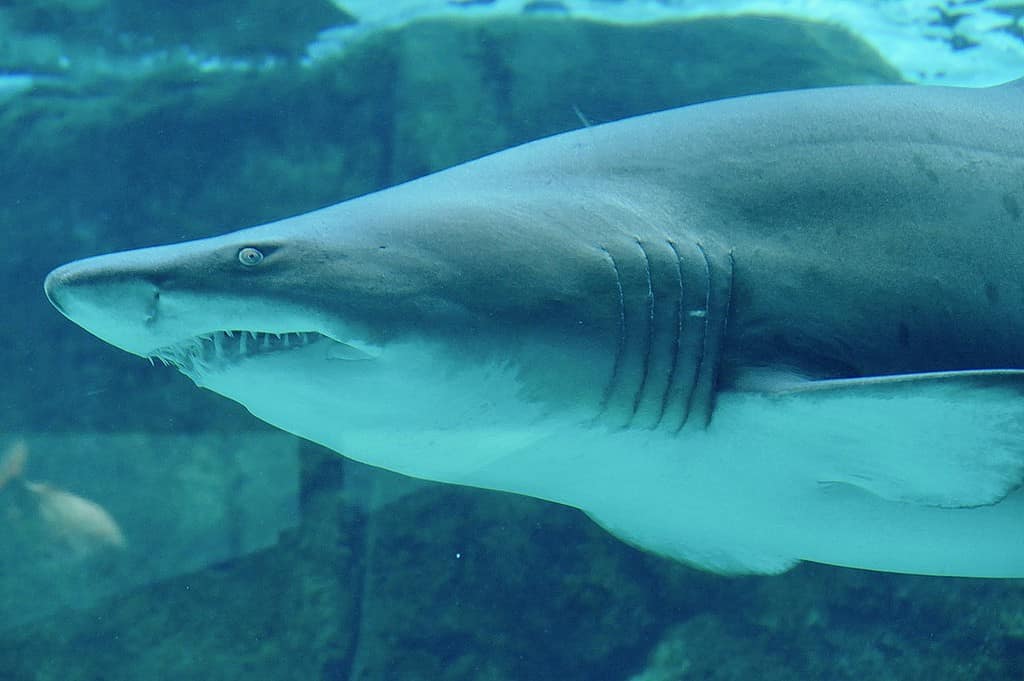
Tiger sharks are considered fairly aggressive when compared to other shark species, but there has been no record of shark bites from them in Aruba in recent history due to the safety precautions taken by locals and tourists.
©Bernard DUPONT from FRANCE / CC BY-SA 2.0 – License
Tiger sharks or Galeocerdo cuvier are formidable predators known for their distinctive appearance and voracious appetite. These sharks can be found in the warm waters of the Caribbean Sea, including the coastal areas around Aruba.
Tiger sharks are aptly named for their striking appearance. They have a powerful body with a gray to bluish-green coloration on their dorsal side. They are often adorned with dark vertical stripes or spots, resembling a tiger’s pattern. Their belly is lighter in color, making them less visible from below. They possess a broad head with sharp, serrated teeth designed for tearing through a variety of prey.
These apex predators have a diverse diet, earning them the moniker “garbage cans of the sea.” Their menu includes fish, sea turtles, seals, dolphins, and even smaller sharks. They are known scavengers, often feeding on carcasses and marine debris. This versatility in diet makes them formidable hunters in a range of marine environments.
In Aruba, tiger sharks can be found in different coastal areas. These areas include offshore reefs, the vicinity of shipwrecks like the Antilla, and deeper waters surrounding the island. These locations are teeming with marine life, making them attractive hunting grounds for tiger sharks.
While tiger sharks are considered one of the more aggressive shark species, there have been no recorded shark attacks involving them in Aruba. These sharks do not actively seek out human encounters and tend to avoid populated areas. However, like all sharks, they should be treated with caution and respect in their natural habitat.
8. Silky Shark
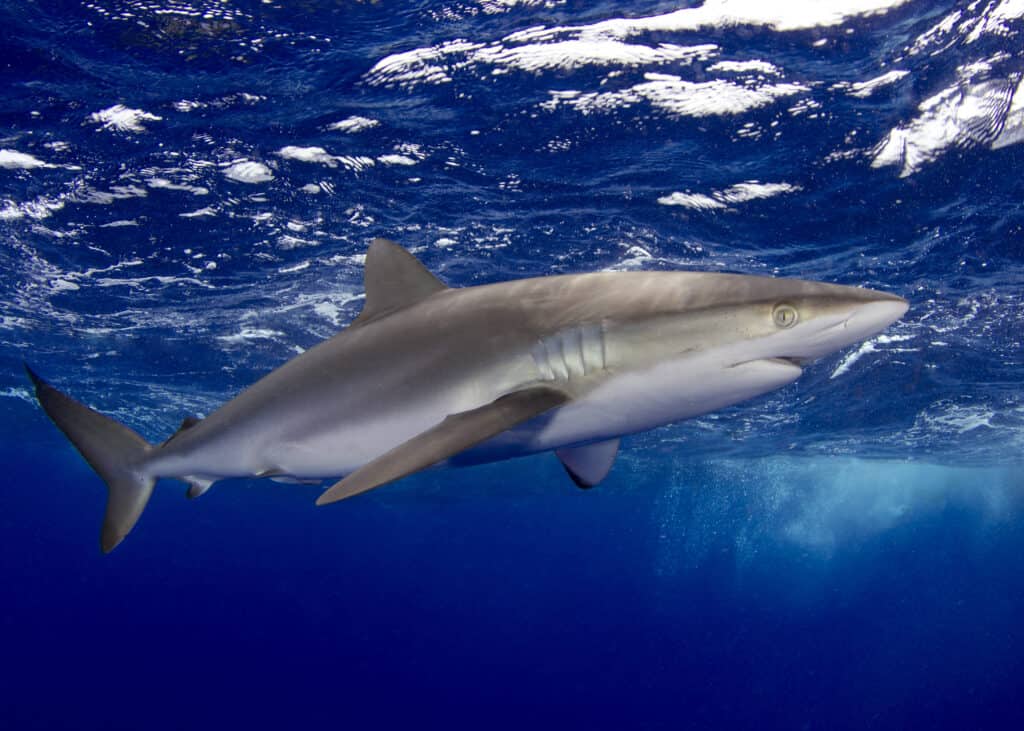
Silky sharks can be found near Renaissance Island and other nearby ocean ridges in the Caribbean, where they hunt for different species of fish and squid.
©Matt9122/Shutterstock.com
Silky sharks or Carcharhinus falciformis are captivating creatures commonly found in the warm waters around Aruba. These sharks possess distinct characteristics and a fascinating place in the marine ecosystem.
Silky sharks often have a smooth, long body form that is ideally adapted for swimming quickly. Their name comes from their metallic look and the glossy, silky texture of their skin. On their dorsal side, silky sharks range in color from bronze to dark gray. Their belly is usually a lighter tint. They swim gracefully in the water thanks in part to their large, curving pectoral fins.
The diet of silky sharks is that of an opportunistic carnivore, as are most sharks. They mostly eat different bony fish species, squid, and pelagic schooling fish, such as tuna and mackerel. These sharks frequently hunt close to the ocean’s surface, using their speed and agility to pursue their food.
In Aruba, offshore seas are regularly home to silky shark sightings, especially around ocean ridges and undersea seamounts. Areas near Renaissance Island and the island’s surrounding waters are known for encounters with silky sharks. These locations attract divers and enthusiasts seeking to observe these magnificent creatures in their natural environment.
Importantly, Aruba has no documented history of shark attacks involving silky sharks. These sharks are generally not considered a threat to humans. They are more interested in pursuing their prey and maintaining their place in the marine food chain.
Summary of Sharks Found in Aruba’s Waters
| # | Shark | Classification |
|---|---|---|
| 1 | Nurse Shark | Ginglymostoma cirratum |
| 2 | Lemon Shark | Negaprion brevirostris |
| 3 | Bull Shark | Carcharhinus leucas |
| 4 | Caribbean Reef Shark | Carcharhinus perezi |
| 5 | Hammerhead Shark | Sphyrna spp. |
| 6 | Blacktip Shark | Carcharhinus limbatus |
| 7 | Tiger Shark | Galeocerdo cuvier |
| 8 | Silky Shark | Carcharhinus falciformis |
The photo featured at the top of this post is © iStock.com/Michael Geyer
Thank you for reading! Have some feedback for us? Contact the AZ Animals editorial team.






